
Artificial intelligence (AI) has revolutionized the way businesses operate by automating processes, improving decision-making, and enhancing customer experiences. AI tools can help businesses of all sizes to analyze large data sets, automate repetitive tasks, and optimize operations. In this blog, we’ll explore the pros and cons of both free and paid AI tools to help you make an informed decision.
Free AI Tools:
TensorFlow
TensorFlow is an open-source software library for dataflow and differentiable programming across a range of tasks. It was developed by the Google Brain team and released in 2015. TensorFlow is designed to facilitate the creation of machine learning models and neural networks and can be used for tasks such as image recognition, natural language processing, and predictive analytics.
One of the main benefits of TensorFlow is its highly customizable nature. TensorFlow allows developers to build custom machine learning models and neural networks, enabling them to tailor the software to their specific needs. Additionally, TensorFlow has a large community that contributes to its development, making it a constantly evolving and improving tool.
TensorFlow has a user-friendly interface and provides various tools for data visualization and debugging, making it easy for developers to track and improve their models. Furthermore, TensorFlow is cross-platform, meaning it can be run on various operating systems, including Windows, Linux, and macOS.
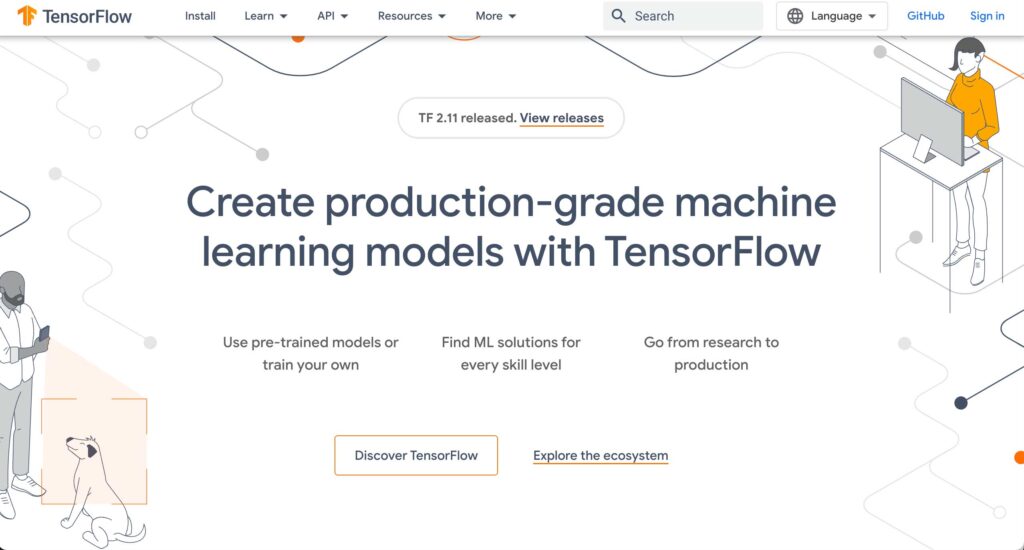
TensorFlow can be used by businesses of all sizes and has been adopted by many leading companies, including Airbnb, Intel, and Twitter. Additionally, TensorFlow is integrated with other Google products, such as Google Cloud, allowing developers to take advantage of additional resources and services.
Overall, TensorFlow is a powerful and highly customizable AI tool that can be used for a wide range of applications. Its flexibility and community support make it a popular choice among developers looking to create advanced machine-learning models and neural networks.
Pros: It’s highly customizable and has a large community that contributes to its development.
Cons: It can be complex to set up and use for beginners.
Weblink: https://www.tensorflow.org/
Keras
Keras is a high-level open-source neural network API written in Python. It was developed by Francois Chollet and was first released in 2015. Keras provides a user-friendly interface for building and training neural networks and can be used on top of other popular machine learning frameworks such as TensorFlow, Microsoft Cognitive Toolkit, and Theano.
One of the main advantages of Keras is its ease of use. It simplifies the process of building neural networks by providing a high-level API that allows developers to easily define layers and connect them to form a complete model. It also comes with a variety of pre-built models that can be used for common tasks, such as image recognition and natural language processing.
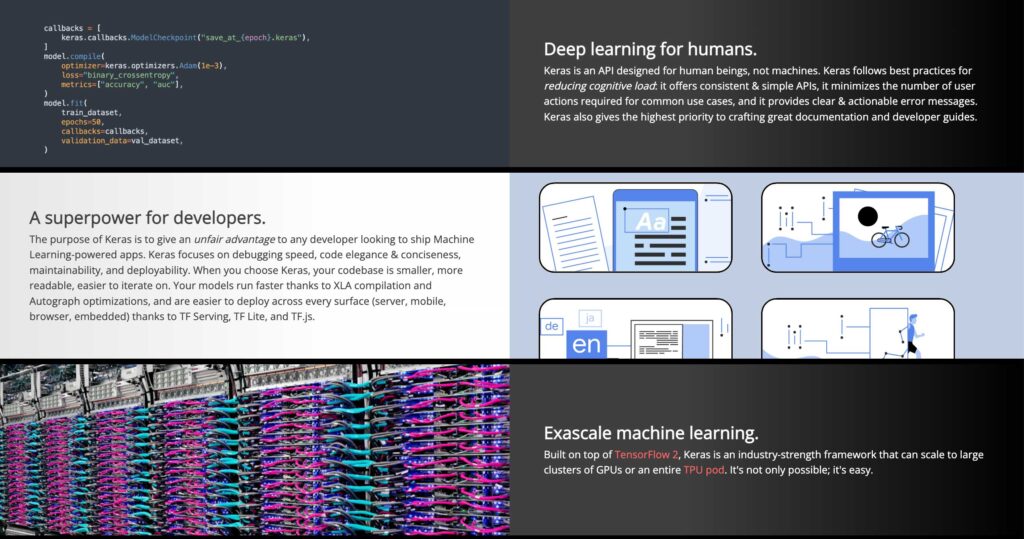
Keras has a large and active community that contributes to its development and provides support for users. It is also highly flexible and customizable, allowing developers to tailor their models to their specific needs. Keras supports both CPU and GPU acceleration, making it suitable for both small and large-scale projects.
Keras has been widely adopted by many leading companies and organizations, such as Uber, Microsoft, and NASA. It has also been used in a variety of research projects, including deep-learning models for medical imaging and climate prediction.
In summary, Keras is a powerful and easy-to-use tool for building and training neural networks. Its user-friendly interface, flexibility, and large community make it a popular choice among developers looking to create advanced machine-learning models.
Pros: It’s easy to use and has a user-friendly interface.
Cons: It may not be as customizable as other AI tools.
Weblink: https://keras.io/
OpenAI
OpenAI is an artificial intelligence research organization founded in 2015 by a group of tech industry leaders, including Elon Musk and Sam Altman. The organization’s mission is to create and promote friendly AI that benefits humanity as a whole. OpenAI has made significant contributions to the field of artificial intelligence, particularly in the areas of natural language processing, robotics, and reinforcement learning.
One of the key features of OpenAI is its commitment to open-source software and knowledge-sharing. The organization makes much of its research and software available to the public, with the aim of advancing the field of AI as a whole. This includes several popular AI tools and libraries, such as OpenAI Gym, a toolkit for developing and comparing reinforcement learning algorithms.
OpenAI has also developed several notable AI models and technologies, including GPT (Generative Pre-trained Transformer), a language processing model that has achieved impressive results in tasks such as language translation and text generation. It has also made significant contributions to the field of robotics, with the development of the Dactyl robotic hand, which has been used to perform complex tasks such as solving Rubik’s cubes and manipulating objects.
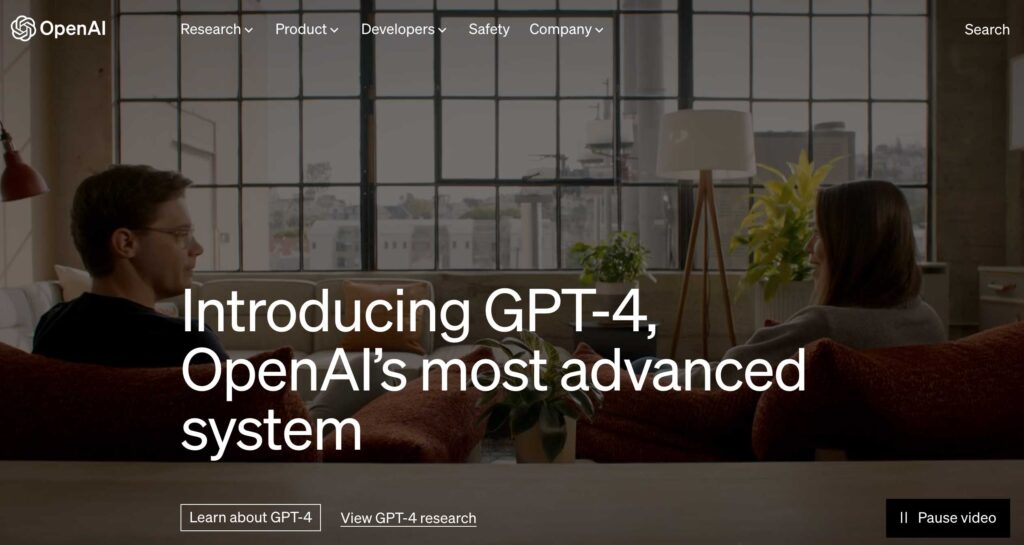
In addition to its research and development efforts, OpenAI has also been involved in various initiatives aimed at promoting AI safety and ethical considerations. The organization has collaborated with various industry and academic partners to create guidelines and best practices for the responsible development and use of AI.
Overall, OpenAI is a leading organization in the field of artificial intelligence, with a strong focus on advancing technology in a responsible and ethical manner. Its commitment to open-source software and knowledge-sharing has made it a valuable resource for developers and researchers worldwide.
Pros: GPT-3 is highly accurate and can generate human-like language.
Cons: OpenAI’s tools can be expensive for small businesses.
ChatGPT
ChatGPT is a large language model trained by OpenAI, based on the GPT-3.5 architecture. It is designed to generate human-like responses to natural language input, making it suitable for use in chatbots and other conversational AI applications.
ChatGPT is capable of understanding and generating responses to a wide range of inputs, including text, voice, and images. It uses advanced natural language processing techniques, including machine learning and deep learning, to generate responses that are contextually appropriate and semantically accurate.
ChatGPT can be customized and trained to respond to specific domains or topics, allowing developers to create chatbots that are tailored to their particular needs. It also supports multi-turn conversations, meaning that it can maintain context across multiple interactions with a user.
One of the key benefits of using ChatGPT is that it can help organizations to reduce the burden on human agents in customer service and support roles. By providing customers with accurate and helpful responses to their queries, ChatGPT can help to improve customer satisfaction and reduce the workload on human agents.
In addition, ChatGPT can be used in a variety of other applications, including virtual assistants, personalization, and content generation. Its ability to understand and generate natural language makes it a versatile tool for a wide range of applications.
Overall, ChatGPT is a powerful tool for developers and organizations looking to create conversational AI applications. Its ability to understand and generate natural language makes it a valuable asset for improving customer engagement and reducing the burden on human agents in customer service and support roles.
DALL-E
DALL-E is a language model created by OpenAI that can generate images from textual descriptions. Unlike traditional image-generating models, DALL-E can create images based on any textual input, not just specific categories or pre-defined styles.
DALL-E is based on the GPT-3 architecture and uses a combination of deep learning algorithms and attention mechanisms to generate images. It is trained on a massive dataset of text and images and uses this data to learn how to generate images from textual descriptions.
One of the unique features of DALL-E is its ability to generate images that are not just realistic, but also creative and surprising. For example, it can create images of animals with patterns that do not exist in real life or generate images of objects that are not physically possible.
DALL-E has many potential applications in fields such as advertising, design, and gaming. For example, it could be used to generate product images for e-commerce websites or to create visual assets for marketing campaigns. It could also be used in the gaming industry to create more immersive and engaging game environments.
However, there are also concerns about the ethical implications of using DALL-E and other similar models. For example, there are concerns about the potential misuse of these models to create deep fakes or other forms of misinformation.
Overall, DALL-E represents an exciting development in the field of AI and has the potential to transform the way we generate and interact with visual content. However, it is important to consider the ethical implications of these technologies and to use them responsibly.
Paid AI Tools:
IBM Watson
IBM Watson is a cognitive computing system that uses machine learning and natural language processing to analyze and understand large amounts of complex data. It was developed by IBM and was first introduced to the public in 2011. IBM Watson is designed to assist businesses and organizations in a variety of industries, including healthcare, finance, and education.
One of the key features of IBM Watson is its ability to process large amounts of unstructured data, such as text, images, and videos. The system can analyze this data and provide insights and recommendations based on its findings. It also has a user-friendly interface that allows non-technical users to interact with the system and receive results in a readable format.
IBM Watson has been used in various industries and applications, including healthcare, where it has been used to assist in medical diagnosis and drug discovery. In finance, IBM Watson has been used for fraud detection and risk management. In education, it has been used to personalize learning experiences for students based on their individual needs and preferences.
IBM Watson also provides a range of tools and services for developers, including APIs and software development kits (SDKs) that can be used to build custom applications and integrations with the system. It’s cloud-based architecture makes it highly scalable and flexible, allowing businesses and organizations to easily integrate it into their existing systems.

Overall, IBM Watson is a powerful and versatile cognitive computing system that has the potential to revolutionize a variety of industries. Its ability to analyze and understand complex data, combined with its user-friendly interface and developer tools, makes it a valuable tool for businesses and organizations looking to gain insights and improve decision-making processes.
Pros: It has a user-friendly interface and a range of applications to choose from.
Cons: It can be expensive for small businesses.
Microsoft Azure AI
Microsoft Azure AI is a suite of artificial intelligence services and tools that are built on the Azure cloud platform. It provides a range of capabilities for developers and data scientists to create and deploy intelligent applications and services. Azure AI includes various services such as machine learning, cognitive services, bot services, and others.
The machine learning service in Azure AI allows developers and data scientists to create predictive models and applications using pre-built algorithms or custom code. It also provides capabilities for data preparation, model training, and deployment. Developers can use Azure Machine Learning Studio or the Azure Machine Learning Python SDK to create and deploy machine learning models.
Cognitive services in Azure AI provide pre-built algorithms and APIs for tasks such as image and speech recognition, language understanding, and sentiment analysis. These services can be easily integrated into applications, allowing developers to add intelligent capabilities without requiring extensive knowledge of machine learning or AI.
Azure Bot Service allows developers to build and deploy intelligent chatbots and virtual agents. It provides pre-built templates, connectors, and tools to make it easy to create bots that can understand natural language and respond appropriately.
Azure AI also includes tools and services for data management, including Azure Data Factory and Azure Databricks. These services allow developers and data scientists to prepare and manage large amounts of data for machine learning and AI applications.
In addition to these services, Azure AI provides various developer tools and APIs for integrating AI capabilities into applications and services. Azure AI also offers a range of deployment options, including deployment to the cloud, on-premises, or edge devices.
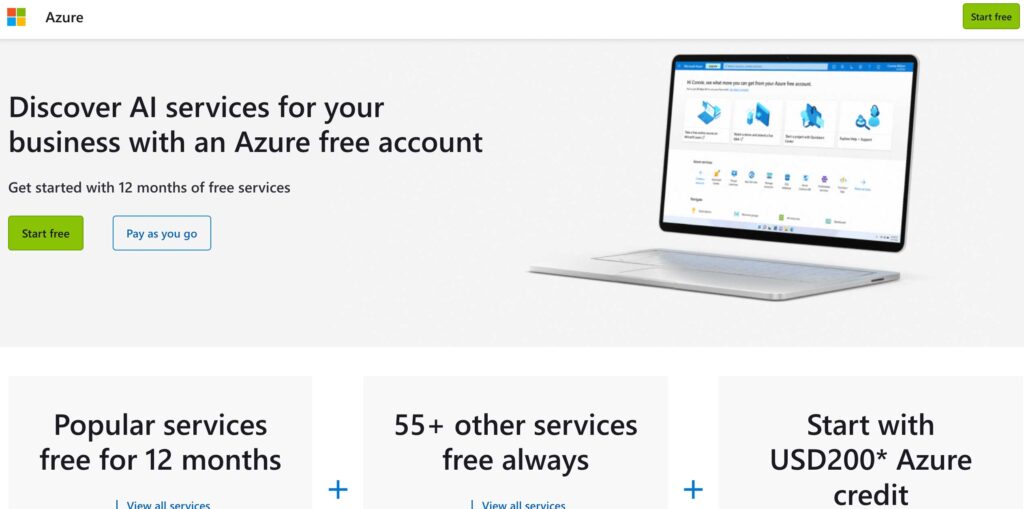
Overall, Microsoft Azure AI provides a comprehensive suite of tools and services for creating and deploying intelligent applications and services. With its easy-to-use developer tools and pre-built algorithms, Azure AI makes it easy for developers and data scientists to add intelligent capabilities to their applications and services, and leverage the power of AI to drive business value.
Pros: It has a range of tools and applications, and integrates well with other Microsoft products.
Cons: It can be complex to set up and use.
Weblink: https://azure.microsoft.com/
Google Cloud AI
Google Cloud AI is a suite of artificial intelligence services and tools that are built on the Google Cloud platform. It provides a range of capabilities for developers and data scientists to create and deploy intelligent applications and services. It includes various services such as machine learning, natural language processing, speech-to-text, and others.
The machine learning service in Google Cloud AI allows developers and data scientists to create predictive models and applications using pre-built algorithms or custom code. It also provides capabilities for data preparation, model training, and deployment. Developers can use Google Cloud AutoML or the Google Cloud Machine Learning Engine to create and deploy machine learning models.
It also includes natural language processing services such as the Cloud Natural Language API, which allows developers to add natural language understanding to their applications. This service can analyze text for sentiment, entity recognition, and syntax analysis.
It provides speech-to-text services such as the Cloud Speech-to-Text API, which allows developers to convert audio and voice into written text. This service is useful for applications such as speech recognition and transcription.
In addition, Google Cloud AI includes tools and services for image and video analysis, including the Cloud Vision API, which can analyze images and detect objects, faces, and other attributes.
It also provides various developer tools and APIs for integrating AI capabilities into applications and services. Google Cloud AI also offers a range of deployment options, including deployment to the cloud, on-premises, or edge devices.
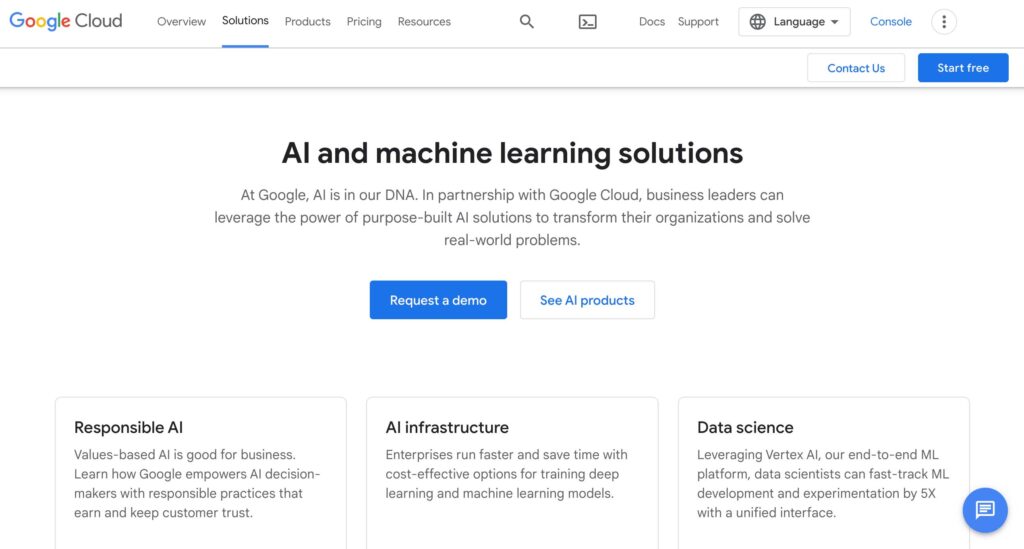
Overall, Google Cloud AI provides a comprehensive suite of tools and services for creating and deploying intelligent applications and services. With its easy-to-use developer tools and pre-built algorithms, It makes it easy for developers and data scientists to add intelligent capabilities to their applications and services, and leverage the power of AI to drive business value.
Pros: It has a range of pre-built APIs and a user-friendly interface. Cons: It can be expensive for small businesses.
Weblink: https://cloud.google.com/
Choosing the right AI tool for your business depends on a variety of factors, including your budget, technical expertise, and business needs. Free AI tools like TensorFlow, Keras, and OpenAI can be a great option for businesses on a tight budget, while paid AI tools like IBM Watson, Microsoft Azure AI, and Google Cloud AI can offer more advanced features and capabilities. Whichever option you choose, be sure to do your research and evaluate the pros and cons to make an informed decision.
Featured Image Attribution: Photo by Andrew Neel: https://www.pexels.com/photo/monitor-screen-showing-chatgpt-landing-page-15863066/


